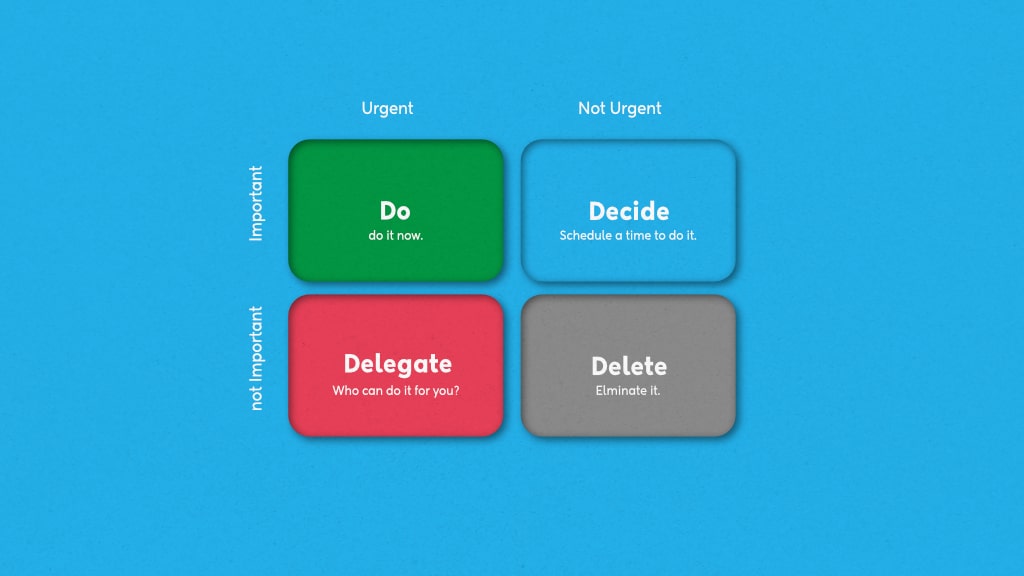“I have two kinds of problems: the urgent and the important. The urgent are not important, and the important are never urgent.” – Dwight D. Eisenhower
I can attest to this – both from my experience and how teams operate – too often we struggle to get our heads around what truly matters versus what simply screams for our attention.
And that’s not just because of the overwhelming number of tasks – it is probably our urge to accomplish more or simply because we lack a clear system to differentiate the urgent from the important.
The result? We spend our days putting out fires instead of making any real, meaningful progress.
This is where the Eisenhower Matrix comes across as a game changer. It has transformed how I approach productivity and decision-making.
Introduced by Dwight D. Eisenhower, the 34th US president, the powerful task management tool helps leaders and teams break the cycle and focus on what truly moves the needle. Because, remember, not everything deserves your time and effort. In this article, we’ll break down how the Eisenhower Matrix works, why it deserves your attention, and how you can start implementing it to prioritize better, make smarter decisions, and take back control of your time and projects.
What is the Eisenhower Matrix?
The Eisenhower Matrix is a task prioritization, time management, and decision-making tool that helps you organize and segregate tasks based on their importance and urgency.
Also, referred to as an Urgent-Important matrix, Eisenhower box, or simply the Eisenhower method, it features a 2×2 grid. The horizontal axis represents ‘Urgent’ and ‘Not Urgent tasks’, while the vertical axis represents ‘Important’ and ‘Not Important tasks’.
The intersection of these axes forms four quadrants, each representing a unique combination of urgency and importance.
- Both important and urgent: Act on them immediately
- Important, but not urgent: Schedule them for later
- Not important, but urgent: Delegate to others
- Neither important nor urgent: Discard them altogether (only when they serve no purpose)
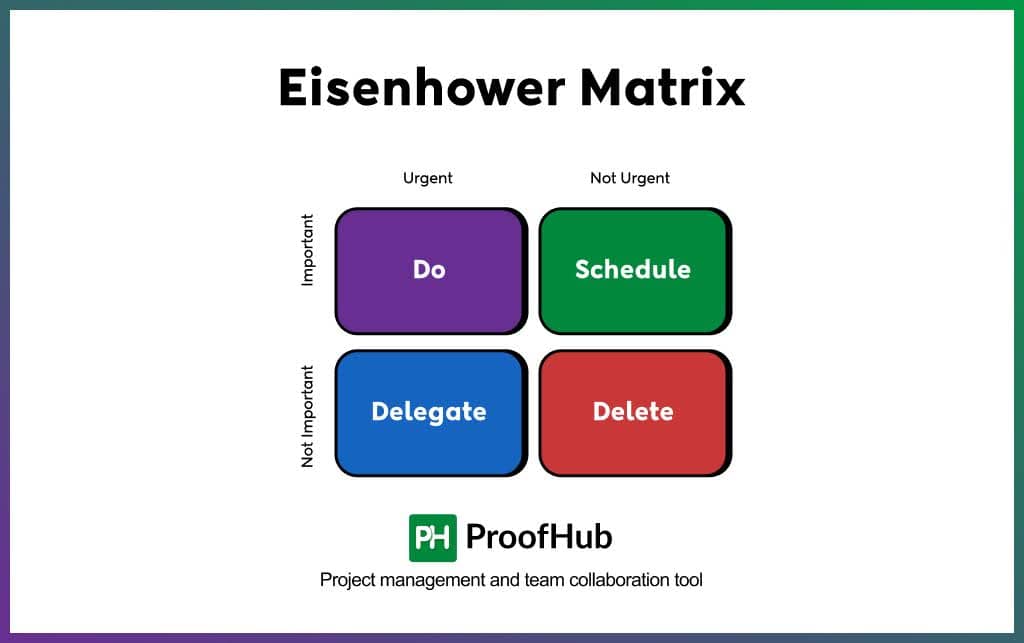
By mapping tasks across these quadrants, you get a clear overview of the priorities, helping you focus on what drives the desired level of productivity and progress.
What are the four quadrants of the Eisenhower Matrix?
The task prioritization method represents four quadrants that are graphically plotted against task importance versus task urgency. These can be summarized as follows:
1. Both important and urgent (Do)
These are the tasks that require your immediate attention – not because they are immediately due but because they have a significant impact on the project. Some examples include:
- Resolving a major client issue
- Addressing a compliance or legal issue
- Finalizing and submitting a project proposal
Action – The key here is to make decisive, strategic moves without rushing. You can also use the ‘Eat the frog’ method to tackle the most critical task first.
2. Important, but not urgent (Schedule)
These are the tasks that are pivotal to your project but not a priority at the moment. You can choose to plan and tackle them later on. Because chances are – If you don’t schedule them, they’ll never happen. Some examples include:
- Conducting a post-mortem analysis
- Upskilling the team with training or workshops
- Researching new technologies or methodologies
Action – I prefer to block time for these tasks on my calendar, treating them as non-negotiable.
3. Not important, but urgent (Delegate)
These are the tasks that demand immediate attention because there might be dependencies. These tasks do not require your expertise and can be delegated to others. Some examples include:
- Handling administrative issues
- Responding to vendor emails
- Formatting reports and presentations
Action – Identify team members who can take ownership of these tasks. Trust your team to handle what you don’t need to do yourself.
4. Neither important nor urgent (Delete)
These are the tasks that neither contribute to your project’s success nor require your immediate attention. You can choose to eliminate them. Some examples include:
- Meetings with no clear agenda
- Manually updating reports
- Engaging in not-so-relevant emails
Action – Let go of tasks that don’t matter. Because every “yes” to a low-value task is a “no” to something that matters.
Categorizing tasks this way facilitates quadrant-based planning. This means you can identify the priority of tasks as per the quadrants and create an execution strategy for each of them.
Remember that the Eisenhower Matrix doesn’t talk about how you should execute a certain task, it assists in task scheduling and prioritization, saving you both time and resources.
Tips to prioritize your tasks using the Eisenhower Matrix
Trust me when I say that when managing several tasks and task lists, it is easy to feel like you are constantly spinning your wheels rather than making meaningful progress.
However, prioritization isn’t just about dividing tasks into four quadrants – it’s about optimizing your prioritization process for better focus and impact.
Here are some actionable strategies you can take to get your day sorted:
1. Create a to-do list of your tasks
Before you start sorting your tasks into four quadrants, list everything down in one place – big or small, urgent or not, important or not. This ensures you have a clear inventory of tasks and nothing falls through the cracks.
My advice: Hold a brain-dumping session to establish weekly goals with key stakeholders. This helps you get a comprehensive perspective and clarity on what truly needs attention.
2. Eliminate then prioritize
Once your list is ready, don’t rush to categorize. Because not everything that demands attention deserves it. Cut out the non-essential tasks to not make it work about work and declutter your list and your mental space.
My advice: Take some time out and analyze the task’s relevancy with overall goals. If nothing substantial comes out, drop it immediately.
3. Avoid overcrowding Quadrant 1
While Eisenhower provides structure, its effectiveness immediately drops if Quadrant 1 is overflowing. If you label everything as urgent and important, then you will always struggle to get your head up the desk, leaving no space for strategic work.
My advice: Cap Quadrant 1 tasks to 5-7 at any given time as per your capacity and workload. If new tasks arise, shift less critical ones to Quadrant 2 or delegate to maintain the balance.
4. Separate personal and professional tasks
While some suggest mixing both personal and professional tasks in one matrix – practice doesn’t work in my favor. I believe both work and personal life operate on different timelines and urgency levels. Combining these two different dimensions can only create a false illusion of balance.
My advice: Maintain separate Eisenhower Matrices—one for work and one for personal life to ensure focus without unnecessary overlap.
5. Use the Pareto Principle (The 80/20 rule)
Not all tasks drive equal impact. So, make sure to apply the 80/20 rule to draw the maximum out of your efforts. The rule suggests that 20% of high-impact tasks contribute to 80% of your results. Identifying these tasks can take you one step ahead.
My advice: Spend 10 minutes daily identifying the 20% of tasks that will create the biggest impact. Prioritize them first.
Learn effective ways to prioritize your tasks for better results
6. Use technology
Managing prioritization manually can be exhausting, and can even cause inefficiencies if not reviewed regularly. Technology can streamline this process by automating sorting, tracking dependencies, and enhancing collaboration.
- Color-code your tasks: Color-coding is an intuitive and quick way to prioritize tasks. According to the Ebbinghaus Forgetting Curve, humans lost 50% of new information within an hour. However, research confirms that when using visuals, the brain processes them 60,000 times faster than the text.
For example:
🟢 Green – Quadrant 1 (Do)
🟡 Yellow – Quadrant 2 (Schedule)
🔵 Blue – Quadrant 3 (Delegate)
🔴 Red – Quadrant 4 (Delete)
- Define priority labels: Instead of vague descriptions, you can use priority labels to clearly communicate your priorities and bring clarity to your workflow.
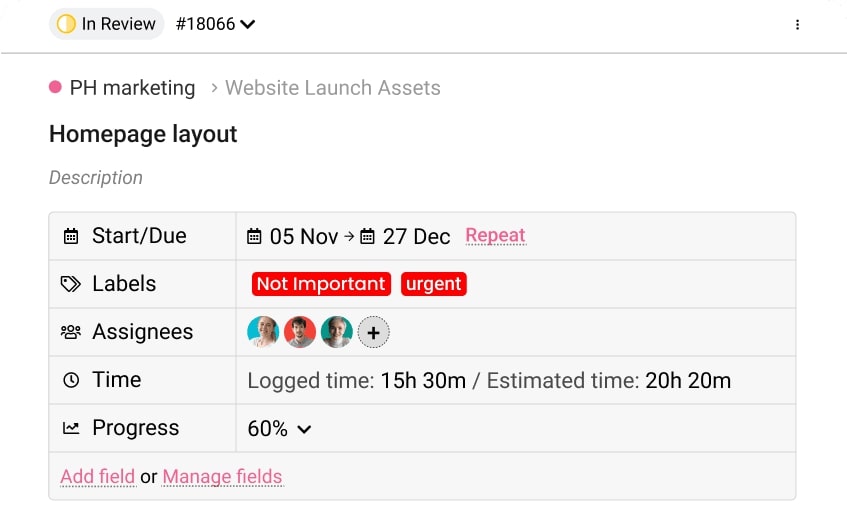
- Set estimated time: Assigning a time estimate to each task helps you understand how to distribute your time across tasks. This helps them not only stay productive but stay on track.
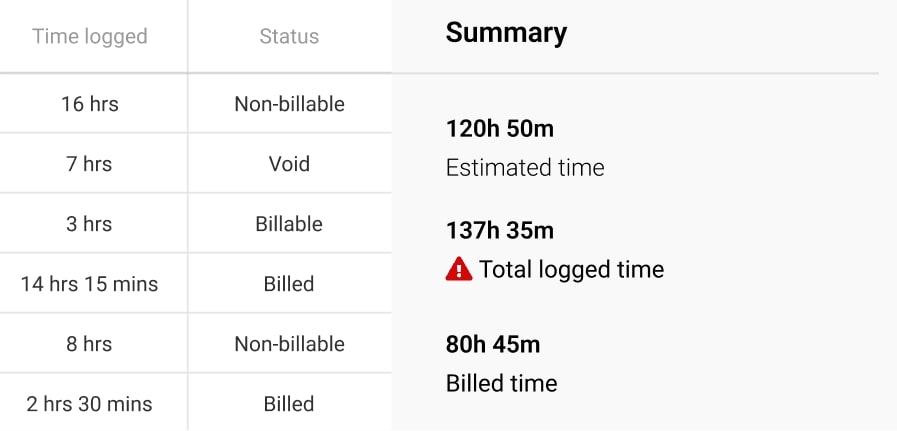
- Use time tracker: Tracking your time across various quadrants can manifest several benefits. For example,
Quadrant 1 – Track time spent on urgent tasks to reduce reactive work.
Quadrant 2 – Monitor progress on strategic work to ensure it’s not neglected.
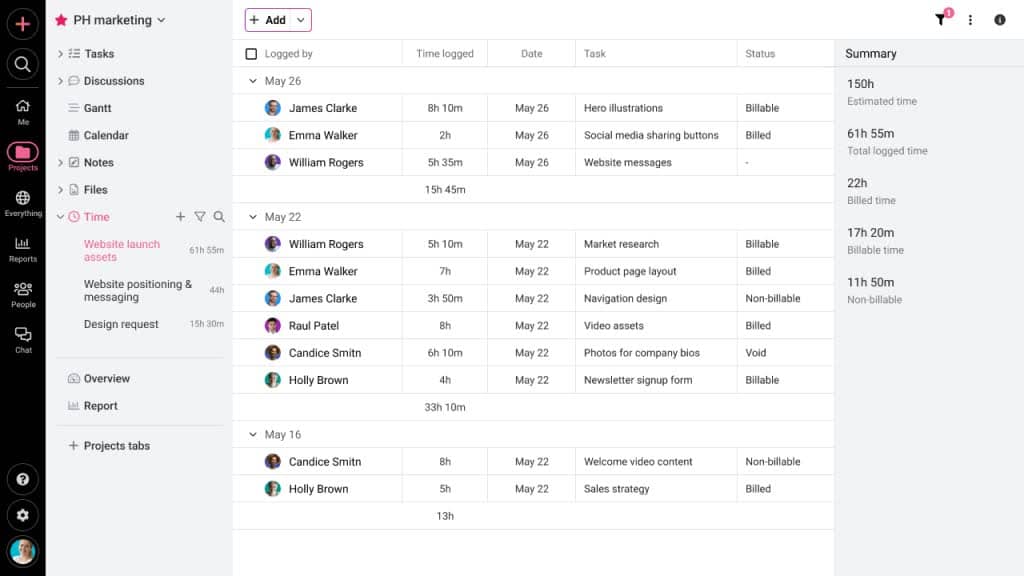
My advice: Use tools like ProofHub to prioritize tasks and maintain focus based on deadlines, dependencies, and workload.
Read More: How to track time – 6 time tracking apps to use
How does the Eisenhower Matrix Benefit you?
“Putting first things first means organizing and executing around your most important priorities. It is living and being driven by the principles you value most, not by the agendas and forces surrounding you.” — Stephen R. Covey
The Eisenhower Decision Matrix helps you put first things first. By getting this one thing right about your daily platter of tasks, you can fundamentally improve the productivity of your project.
1. Effective decision-making
The decision matrix helps managers clearly understand the nature of each task and prioritize them accordingly. This clarity allows for more informed and strategic decisions.
2. Enhanced productivity
When teams spend the majority of time on high-impact tasks, they spend less time contemplating and more time performing and achieving. Doing this they also get time for everything in between.
3. Reduced stress and burnout
The structured prioritization introduces order, making the day seem less chaotic and more manageable. This helps your team gain more control over their schedule and avoid last-minute scrambles and anxiety.
4. Better time management
The time management matrix enables managers to effectively plan and manage their team’s time across Quadrants 1 and 2, ensuring that critical and strategic work gets done first without any pressure.
5. Improved team performance
When managers set clear priorities and stack tasks in an achievable order, teams can align their efforts without unnecessary distractions. This leads to a more focused, self-motivated, and high-performing workforce.
6. Smarter resource allocation
By gaining better visibility into task priorities and time distribution, you can make smarter decisions about resource allocation.
Discover our comprehensive guide on resource allocation
What is the difference between urgent and important tasks?
Urgent and important tasks form the basis of the Eisenhower Matrix. However, I have often found individuals struggling to differentiate between the two – mistaking urgent for important and jumping on every task, regardless of whether it is substantial to the broader vision or not. This reactive approach surely makes you look busy but not progressive at all.
1. Urgent tasks
These tasks are time-sensitive and demand immediate attention. They often come with potential risks and consequences that can significantly impact project success. If not completed within the defined timeframe, they may lead to missed opportunities, escalations, or operational setbacks.
Examples of urgent tasks:
- Finishing a critical bug for a product launch
- Meeting a project deadline
- Preparing a presentation for an urgent stakeholder meeting
2. Important tasks
These tasks do not require immediate action but have a major impact on the project, business outcomes, or long-term goals. Prioritizing important tasks ensures sustainable growth and prevents last-minute chaos.
Examples of important tasks:
- Strategic planning for the next quarter
- Setting up automation to improve efficiency
- Regular performance reviews with team members
If you still find it difficult to differentiate between the two, here is a quick trick: For example, when evaluating the nature of your task, ask yourself – “Will this task contribute to long-term success in the near or distant future?”
If it’s a yes – The task is likely important.
If it’s a no, but it demands immediate attention – The task is merely urgent.
Example of Eisenhower Matrix
Now that you have a comprehensive understanding of the nitty-gritty of the Eisenhower Matrix, let’s put this productivity framework into practice. Below I have mentioned how the matrix works in real-world scenarios:
1. Project managers
Quadrant 1: Both important and urgent (Do)
- Resolving a critical issue
- Approving last-minute changes
- Resolving conflict among stakeholders
- Managing resource shortage
- Addressing a client complaint
Quadrant 2: Important, but not urgent (Schedule)
- Developing a resource allocation strategy
- Creating a structured feedback loop
- Reviewing and workflow optimization
- Identifying skill gaps among teams
- Researching new industry trends
Quadrant 3: Not important, but urgent (Delegate)
- Updating Gantt charts and task dependencies
- Organizing project files and documentation
- Following up on minor action items
- Sending out meeting notes and summaries
- Handling minor IT requests
Quadrant 4: Neither important nor urgent (Delete)
- Manually tracking project metrics
- Attending social or networking events
- Customizing reports beyond what’s necessary
- Engaging in unstructured brainstorming sessions
- Constantly revising project presentation
2. Scrum managers
Quadrant 1: Both important and urgent (Do)
- Fixing a high-priority bug
- Resolving conflicts within the development team
- Managing a sudden performance issue
- Aligning the team with shifting priorities
- Addressing a sudden team capacity
Quadrant 2: Important, but not urgent (Schedule)
- Refining the product backlog
- Conducting sprint retrospectives
- Enhancing cross-team collaboration
- Researching emerging Agile methodologies
- Exploring automation tools
Explore our comprehensive list of workflow automation tools for 2025
Quadrant 3: Not important, but urgent (Delegate)
- Handling administrative tasks
- Sending calendar invites
- Collecting past sprints’ feedback
- Handling minor IT requests
- Following up on minor action items
Quadrant 4: Neither important nor urgent (Delete)
- Overanalyzing sprint velocity
- Constantly tweaking team workflows
- Meetings irrelevant to the Scrum process
- Micromanaging developers
- Overanalyzing Agile tools
Conclusion
Great leaders don’t let urgency dictate their decisions—they intentionally make space for what matters most.
However, in the absence of a clear prioritization structure, sorting through your to-do list can become so overwhelming that even the most experienced managers end up making reactive or rushed decisions. That’s where the Eisenhower Matrix steps in – not just as a tool—but acts as a decision-making framework to bring intentionality into practice.
It empowers you to think strategically before acting immediately, schedule proactively instead of deferring indefinitely, delegate wisely rather than overcommitting, and eliminate distractions before they consume valuable time.
That said, manually managing the matrix can feel like a task itself. However, several task management tools like ProofHub can make the execution seamless. With features like task management, time tracking, and team collaboration, ProofHub helps managers streamline execution, ensure alignment, and turn strategic priorities into real progress.
FAQs
Can the Eisenhower Matrix help with work-life balance?
Yes, the Eisenhower Matrix can help with work-life balance – but to some extent. It helps you prioritize and focus on tasks that matter, without getting caught up in unnecessary urgency. By delegating or eliminating unnecessary tasks, you can create space for both professional and personal priorities. However, achieving true balance requires more than just prioritization; it demands setting clear boundaries, managing your energy effectively, and intentionally making time for rest and personal well-being.
What are common mistakes people make when using the Eisenhower Matrix?
There are several mistakes people make when using the matrix. Some of them include:
- Failing to regularly review and adjust priorities as the circumstances change.
- Struggling to differentiate between urgent and important tasks.
- Piling too many tasks into quadrant 1, i.e., important and urgent tasks and operating in crisis mode.
- Pushing aside the quadrant 2 tasks, i.e. important, but not urgent, and eventually, neglecting them.
- Hesitating to delegate tasks of quadrant 3, i.e., not important but urgent, to others.
- Failing to regularly review and adjust priorities as the circumstances change.
What are the limitations of the Eisenhower Matrix?
While the Eisenhower Matrix is great for prioritization, it has its own limits:
- The rigid structure doesn’t always accommodate shifting priorities and complex workflows.
- Delegation isn’t always feasible, especially with the limited resources or extensive team workload.
- Doesn’t account for effort vs. impact when evaluating which tasks provide the most value relative to the time and energy required.
- This can lead to procrastination if Quadrant 2 tasks (Important but Not Urgent) are constantly pushed.
- It is not an extensive solution for execution and supports prioritization only.
